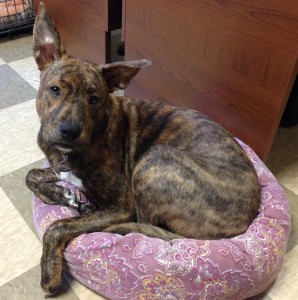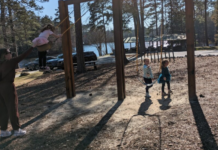 I have a pit bull. I have a toddler. No, I am not insane.
I have a pit bull. I have a toddler. No, I am not insane.
Let’s start at the beginning. In June 2013, on a bit of a whim and without a ton of forethought, I adopted a five-month-old pit bull puppy named Murphy. He came into our family with a fair amount of baggage but quickly became an integral part of our lives. We worked on earning his trust and he worked on believing in our love. There may have been treats involved.
Then two years later, we completely flipped the script on him and brought home a tiny, squalling, red-faced infant. I have written about his transition from top dog to baby assistant before, but two recent events have spurred me to talk more about my dog who looks and sounds like the big, scary breed you’ve been conditioned to see.

A few weeks ago, a popular mom blogger posted a short video of her children interacting with her pug. The pug, used to the kids she lives with, was exhibiting classic signs of stress – the whites of her eyes clearly visible, panting heavily and trying desperately to get out of the literal corner she was in.
As concerned comments flooded the page, the blogger kept insisting that she knew her dog’s limits and that the children were never in danger. And while that may certainly be true and the children’s health is of the utmost importance, the stress and responsibility levied on an animal was harmful. The dog was doing everything she knew to do to tell her owner she was uncomfortable and that she needed help, and it was ignored for laughs.
The second event in recent memory resulted in the death of an elderly woman after a newly adopted and fear-trained pit bull attacked her. The sensational headlines have demonized a breed that I love once again, but the real culprit is that of fear-based or dominance-based training. By teaching dogs that humans are exacting of revenge and not kindness (and treats), they only know fear, and that fear often manifests in violence. My heart breaks for the family who lost a loved one, but to me, the guilt lies in the training methods employed, not a breed at large.
Dogs can’t speak for themselves so as their caretakers, we have to speak for them. With a rambunctious toddler running around, I know that my dogs are more stressed than they were prior to her birth. And that knowledge and acceptance that they are in fact animals has helped me keep them and her safe.
At the first signs of additional stress, we remove them from the situation. Sometimes, that means they go outside for a bit; sometimes, they go to a bedroom. But never are they punished for needing space. And never, ever are they punished for letting us know that they needed space, whether that signal was a widening of the eyes, trying to avoid the toddler, or yes, even growling at her.
I do not need them not to growl. I need my child to respect the growl and understand that when Murphy “talks” to her, he needs her to leave him alone. Respecting the growl keeps them both safe.
So if you have a dog and children, hope is not lost. Not by a long shot. There are countless ways to incorporate your pets with your kids safely and happily, but always accepting that your dog is an animal and that needs to be appreciated.















I have a pit bull as well and people always look at me crazy when I say I have one. Our Max is nothing but a big baby and we love him. We’ve had him for three years and he’s never once got aggressive with us. He does growl sometimes when we’re clipping his nails or trying to get him in the tub but I think it’s only because he’s uncomfortable. When he does, I back off and try again later. Thank you for writing this post.